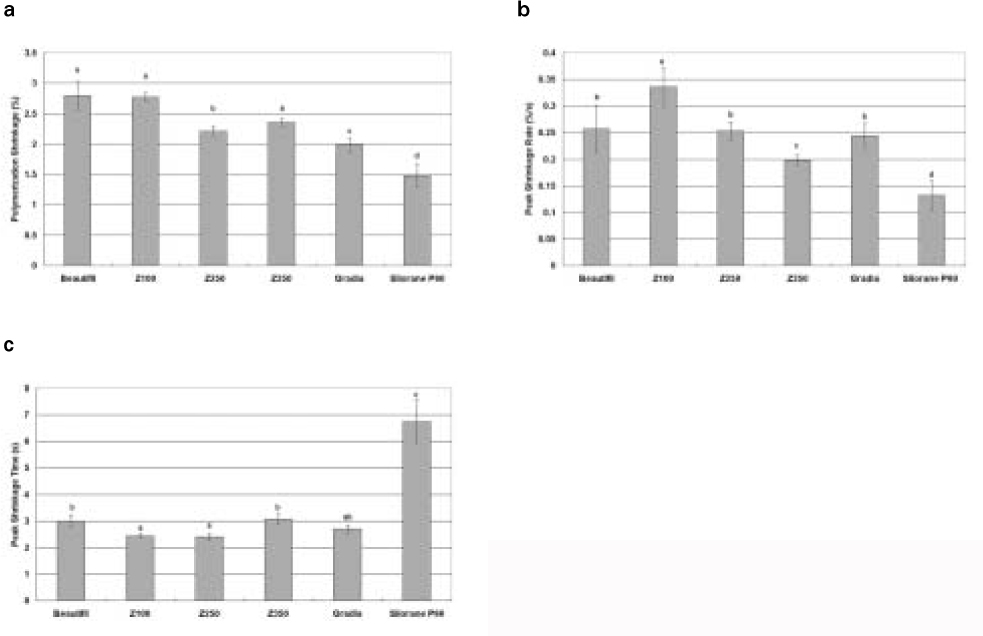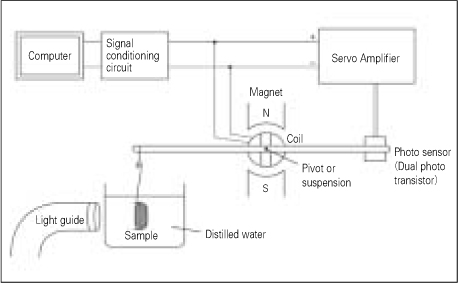Articles
- Page Path
- HOME > Restor Dent Endod > Volume 35(1); 2010 > Article
- Basic Research Polymerization shrinkage kinetics of silorane-based composites
- Youngchul Kwon, In-Bog Lee
-
2010;35(1):-58.
DOI: https://doi.org/10.5395/JKACD.2010.35.1.051
Published online: January 31, 2010
Department of Conservative Dentistry, School of Dentistry, Seoul National University, Korea.
- Corresponding Author: In-Bog Lee. Department of Conservative Dentistry & Dental Research Institute, School of Dentistry, Seoul National University, 275-1 Yoengeon-Dong, Jongno-Gu, Seoul 110-786, Korea. Tel: 82-2-2072-3953, Fax: 82-2-2072-3859, inboglee@snu.ac.kr
Copyright © 2010 Korean Academy of Conservative Dentistry
- 1,128 Views
- 7 Download
- 3 Crossref
Abstract
-
Dental composites have improved significantly in physical properties over the past few decades. However, polymerization shrinkage and stress is still the major drawback of composites, limiting its use to selected cases. Much effort has been made to make low shrinking composites to overcome this issue and silorane-based composites have recently been introduced into the market.The aim of this study was to measure the volumetric polymerization shrinkage kinetics of a silorane-based composite and compare it with conventional methacrylate-based composites in order to evaluate its effectiveness in reducing polymerization shrinkage.Five commercial methacrylate-based (Beautifil, Z100, Z250, Z350 and Gradia X) and a silorane-based (P90) composites were investigated. The volumetric change of the composites during light polymerization was detected continuously as buoyancy change in distilled water by means of Archemedes'principle, using a newly made volume shrinkage measurement instrument. The null hypothesis was that there were no differences in polymerization shrinkage, peak polymerization shrinkage rate and peak shrinkage time between the silorane-based composite and methacrylate-based composites. The results were as follows:
The shrinkage of silorane-based (P90) composites was the lowest (1.48%), and that of Beautifil composite was the highest (2.80%). There were also significant differences between brands among the methacrylate-based composites.
Peak polymerization shrinkage rate was the lowest in P90 (0.13%/s) and the highest in Z100 (0.34%/s).
The time to reach peak shrinkage rate of the silorane-based composite (P90) was longer (6.7 s) than those of the methacrylate-based composites (2.4-3.1 s).
Peak shrinkage rate showed a strong positive correlation with the product of polymerization shrinkage and the inverse of peak shrinkage time (R = 0.95).
- 1. Peutzfeldt A. Resin composites in dentistry: the monomer systems. Eur J Oral Sci. 1997;105: 97-116.ArticlePubMed
- 2. Braga RR, Ferracane JL. Alternatives in polymerization contraction stress management. Crit Rev Oral Biol Med. 2004;15(3):176-184.ArticlePubMed
- 3. Davidson CL, Feilzer AJ. Polymerization shrinkage and polymerization shrinkage stress in polymer-based restoratives. J Dent. 1997;25: 435-440.ArticlePubMed
- 4. Lee IB. J Korean Dent Assoc. 2008;46: 424-430.
- 5. Park JG, Cho BH, Lee IB, Kwon HC, Um CM. The Effects of Various Light Intensity on the Polymerization of Resin Composites. J Korean Acad Conserv Dent. 2001;26: 86-94.
- 6. Feilzer AJ, Dooren LH, de Gee AJ, Davidson CL. Influence of light intensity on polymerization shrinkage and integrity of restoration-cavity interface. Eur J Oral Sci. 1995;103: 322-326.ArticlePubMed
- 7. Watts DC, Cash AJ. Determination of polymerization shrinkage kinetics in visible light-cured materials: methods development. Dent Mater. 1991;7: 281-287.ArticlePubMed
- 8. Miyazaki M, Hinoura K, Onose H, Moore BK. Effects of filler content of light-cured composites on bond strength to bovine dentine. J Dent. 1991;19: 301-303.PubMed
- 9. Venhoven B.A.M., de Gee A.J., Davidson CL. Polymerization contraction and conversion of light-curing BisGMA-based methacrylate resins. Biomaterials. 1993;14(11):871-875.PubMed
- 10. Palin WM, Fleming GJP, Nathwani H, Burke FJT, Randall RC. In vitro cuspal deflection and microleakage of maxillary premolars restored with novel low-shrink dental composites. Dent Mater. 2005;21: 324-335.ArticlePubMed
- 11. Feilzer AJ, de Gee AJ, Davidson CL. Setting stress in composite resin in relation to configuration of the restoration. J Dent Res. 1987;66: 1636-1639.ArticlePubMedPDF
- 12. Segura A, Donly KJ. In vitro posterior composite polymerization recovery following hygroscopic expansion. J Oral Rehabil. 1993;20: 495-499.ArticlePubMed
- 13. Park JK, JH Chang, Lee IB. How should composite be layered to reduce shrinkage stress: Incremental or bulk filling? Dent Mater. 2008;24: 1501-1505.ArticlePubMed
- 14. Lee MR, Cho BH, Son HH, Um CM, Lee IB. Influence of cavity dimension and restoration methods on the cusp deflection of premolars in composite restoration. Dent Mater. 2007;23: 288-295.ArticlePubMed
- 15. Sahafi A, Peutzefeld A, Asmussen E. Effect of pulse-delay curing on in vitro wall-to-wall contraction of composite in dentin cavity preparations. Am J Dent. 2001;14: 295-296.PubMed
- 16. Obici AC, Sinhoreti MAC, de Goes MF, Consai S, Sobrinho LC. Effect of the photo-activation method on polymerization shrinkage of restorative composites. Oper Dent. 2002;27: 192-198.PubMed
- 17. Kemp-Scholte CM, Davidson CL. Complete marginal seal of Class V resin composite restorations effected by increased flexibility. J Dent Res. 1990;69: 1240-1243.ArticlePubMedPDF
- 18. Feilzer AJ, de Gee AJ, Davidson CL. Curing contraction of composites and glass ionomer cements. J Prosthet Dent. 1988;59: 297-300.ArticlePubMed
- 19. Weinmann W, Thalacker C, Guggenberg R. Siloranes in dental composites. Dent Mater. 2005;21: 68-74.ArticlePubMed
- 20. Stansbury JW, Trujillo-Lemon M, Lu H, Ding X, Lin Y, Ge J. Conversion-dependent shrinkage stress and strain in dental resins and composites. Dent Mater. 2005;21: 56-67.ArticlePubMed
- 21. Papadogiannis D, Kakaboura A, Palaghias G, Eliades G. Setting characteristics and cavity adaptation of low-shrinking resin composites. Dent Mater. 2009;25: 1509-1516.ArticlePubMed
- 22. Miletic V, Ivanovic V, Dzeletovic B, Lezaja M. Temperature changes in Silorane-, Ormocer-, and Dimethacrylate-based composites and pulp chamber roof during light-curing. J Esthet Restor Dent. 2009;21: 122-132.ArticlePubMed
- 23. Lee IB, Cho BH, Son HH, Um CM. A new method to measure the polymerization shrinkage kinetics of light cured composites. J Oral Rehabil. 2005;32: 304-314.ArticlePubMed
- 24. Ellakwa A, Cho NK, Lee IB. The effect of resin matrix composition on the polymerization shrinkage and rheological properties of experimental dental composites. Dent Mater. 2007;23: 1229-1235.ArticlePubMed
- 25. Lee IB. A new method - Real time measurement of the initial dynamic volumetric shrinkage of composite resins during polymerization. J Korean Acad Conserv Dent. 2001;26: 134-140.
- 26. Chappelow CC, Pinzino CS, Power MD, Eick JD. Photocured epoxy/SOC matrix resin systems for dental composites. Polymer Reprints. 1997;38: 90-91.
- 27. Cadenaro M, Biasotto M, Scuor N, Breschi L, Davidson CL, Lenarda R. Assessment of polymerization contraction stress of three composite resins. Dent Mater. 2008;24: 681-685.ArticlePubMed
- 28. Ferracane JL. Developing a more complete understanding of stresses produced in dental composites during polymerization. Dent Mater. 2005;21: 36-42.ArticlePubMed
REFERENCES


Tables & Figures
REFERENCES
Citations

- Comparison of polymerization shrinkage of dual-cure core build-up resin according to shade and curing mode
Yoorina Choi, Karl Lee, Hoon-Sang Chang
Oral Biology Research.2019; 43(4): 243. CrossRef - Evaluation of polymerization shrinkage stress in silorane-based composites
Seung-Ji Ryu, Ji-Hoon Cheon, Jeong-Bum Min
Journal of Korean Academy of Conservative Dentistry.2011; 36(3): 188. CrossRef - A new method to measure the linear polymerization shrinkage of composites using a particle tracking method with computer vision
In-Bog Lee, Sun-Hong Min, Deog-Gyu Seo, Sun-Young Kim, Youngchul Kwon
Journal of Korean Academy of Conservative Dentistry.2010; 35(3): 180. CrossRef



Figure 1
Figure 2
Figure 3
Composites used in this study
Polymerization shrinkage (%) at 10 min, peak shrinkage rate (%/s), peak shrinkage time (s), and the inverse of peak shrinkage time (1/s) of composites
Mean values with the same superscripts are not significantly different (p > 0.05).
Number in parenthesis is standard deviation.
Correlation analysis among polymerization shrinkage (%), peak shrinkage rate (%/s), peak shrinkage time (s), the inverse of peak time (1/s), and the product of polymerization shrinkage and the inverse of peak time of the composites
Mean values with the same superscripts are not significantly different (p > 0.05). Number in parenthesis is standard deviation.

 KACD
KACD




 ePub Link
ePub Link Cite
Cite

